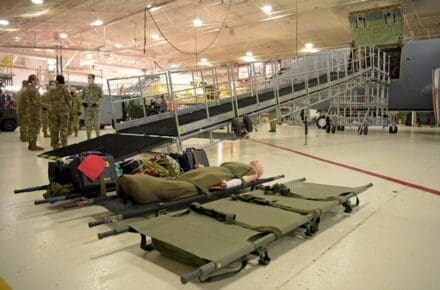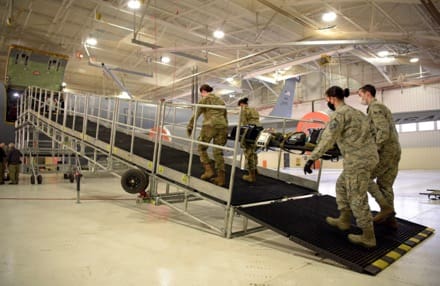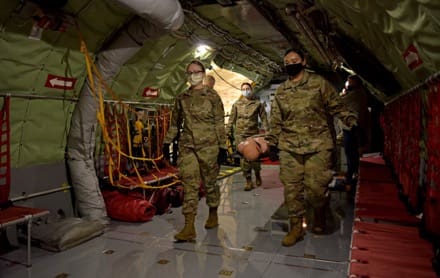SCOTT AIR FORCE BASE, Ill. (AFNS) —
Air Mobility Command hosted the final operational demonstration for the Patient Loading System at Scott Air Force Base, Jan. 25-28.
The PLS is a portable and constructable ramp used to safely on and offload patients to high-deck aircraft, such as the KC-10 Extender, KC-46 Pegasus and KC-135 Stratotanker.

“This upgraded system represents a new frontier in our ability to support the global aeromedical evacuation mission,” said Brig. Gen. Norman West, AMC command surgeon.
Eight medical technicians from the 375th Medical Group were first trained on how to construct the system, then assembled it to demonstrate the capability to AMC leaders.
“Our AE system is designed to make us self-sufficient, so we don’t have to rely on non-medical staff to load our patients or equipment,” said Lt. Col. Todd Roman, medical modernization division chief at the AMC Office of the Surgeon General. “We have to teach our staff to put this together, which is what we’re doing this week. We’re also testing to see how long it takes to put it together.”

According to Roman, the goal is for an eight-person medical team to construct the system within eight hours. Despite having never seen it before, the team met all assembly requirements. They also provided invaluable feedback to improve instructions and ease of assembly as the system moves to final production.
“The ability to configure the device to meet the requirements of all three high-deck aircraft allows us to be adaptable to the aircraft available, even in the most resource-limited environment,” West said.
The current PLS design has multiple drawbacks, including weight limitations and steeper ramp incline. Additionally, since it was designed for Civil Air Reserve Fleet aircraft, its military utility is limited to the KC-135.

During AE missions that use low-deck aircraft, such as the C-17 Globemaster III and C-130 Hercules, patients can simply be carried on and off the aircraft. But high-deck aircraft present a unique challenge.
“For our high-deck aircraft, we need a mechanism to get our patients from the ground to deck level,” Roman said. “The PLS is designed to provide a safe, alternative method to loading patients when mechanical means are not available.
“This is a significant accomplishment from a strategic standpoint, because in this peer/near-peer competition, we can now use nearly any cargo aircraft for AE missions,” Roman continued.
The system also allows AMC to better project the joint force, one of its four command priorities focused on rapidly delivering combat power, humanitarian aid and disaster response, anywhere in the world and at a moment’s notice.
“The U.S. Air Force AE system is world-class and has been adapting to ‘aircraft of opportunity’ even before the retirement of the C-9A Nightingale, which was AMC’s last dedicated AE airframe,” Roman said. “This system further improves our AE capability by giving combatant commanders greater flexibility in our ability to evacuate patients using any available aircraft, regardless of available base support.”
By MSgt R.J. Biermann, Air Mobility Command Public Affairs


HOnestly, when I looked at the first picture I thought it was one of the automated baggage loader conveyor belts. Turns out it is just a regular ramp. I know this helps with patient safety and all, but I feel let down. Conveyor belts seems so much cooler.
It is great to see Air Refueling Tankers in the spotlight and showing another mission set besides Air Refueling.
Eight hours for eight medical personnel to construct. How permanent is this thing? That’s a lot of man hours. Misstatement? Good to see aircraft being utilized in nontraditional roles like this.